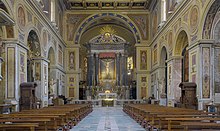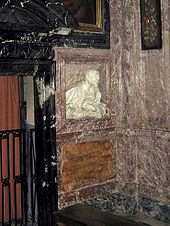San Lorenzo in Lucina
This article needs additional citations for verification. (March 2016) |
| Basilica of St. Lawrence in Lucina | |
|---|---|
| Basilica S. Laurentii in Lucina (in Latin) | |
Basilica di San Lorenzo in Lucina | |
minor basilica | |
| Architecture | |
| Architectural type | Church |
| Groundbreaking | AD 4th century |
| Specifications | |
| Length | 65 metres (213 ft) |
| Width | 16 metres (52 ft) |
| Nave width | 18 metres (59 ft) |
| Clergy | |
| Cardinal protector | Malcolm Ranjith |
The Minor Basilica of St. Lawrence in Lucina (
History
The basilica is dedicated to
The church was consecrated by Pope Celestine III on 26 May 1196.[1]
In 1606 Pope Paul V assigned the basilica to the order of Clerics Regular Minor. Cosimo Fanzago completely renovated the interior in the 17th century, including conversion of the side aisles of the basilica into chapels. The ceiling was also frescoed by the Neapolitan Mometto Greuter.
In the 19th century, in a subsequent restoration of the interior commissioned by Pope Pius IX, the Baroque decoration of the nave was replaced with frescoes painted by Roberto Bompiani.
The current
Art and architecture

In the rebuilding of 1650, the aisled basilical plan was destroyed and the lateral naves were replaced by Baroque chapels, which were then leased to noble families to decorate and use as mausolea. This was done by inserting walls behind the piers of the arcades. The arcades themselves have solid, square piers with imposts. The flat ceiling is coffered, gilded, and decorated with rosettes and has a painting of the Apotheosis of St. Lawrence in the central panel. This ceiling was made in 1857 under Pope Pius IX.
Guido Reni's Christ on the Cross (1639–40)[3] is visible above the high altar, framed by six Corinthian columns of black marble. Below the altar is a reliquary in which is preserved the gridiron on which tradition maintains that St. Lawrence was martyred. The marble throne of Pope Paschal II in the apse behind the high altar has an inscription that records the translation to the basilica of its relics of St. Lawrence of Rome. A Madonna and Child with John of Nepomuk and Archangel Michael by Onofrio Avellino hangs in the apse behind the high altar.

Gian Lorenzo Bernini designed the Cappella Fonseca, fourth on the right, for the Portuguese Gabriele Fonseca, who was physician to Pope Innocent X (1644–55).[4] The chapel has some fine busts by Bernini and his workshop, including a portrait of Fonseca to the left of the altar. This chapel also has the painting Elisha Pouring Salt into the Bitter Fountain by Giacinto Gimignani of 1664.
The French artist Nicolas Poussin (1594–1665) is buried in the second chapel on the right side and is commemorated with a monument that the French Ambassador François-René de Chateaubriand donated in 1830.
The second chapel on the left has an altarpiece by Carlo Saraceni.
The fifth chapel on the left was designed and decorated by
Giuseppe Sardi designed the baptistery to the left of the entrance in the 17th century.
In the basilica is also the tomb of the composer Bernardo Pasquini (1637-1710). Three years after the composer's death, his portrait was placed there, sculpted in Carrara marble by Pietro Francesco Papaleo (circa 1642–1718). The portrait was a commission by the composer's nephew Felice Bernardo Ricordati and his pupil Bernardo Gaffi.
Charles Stewart, an officer in the Papal army who died in 1864, is buried in the basilica. He was the son of John Stewart, Prince Charles Edward Stuart's ("Charles III", the "Young Pretender") "maestro di casa". Charles had ennobled John as a baronet in 1784.
Just outside the Basilica is the original sculpture of When I was a Stranger, created by Canadian artist Timothy Schmalz as part of the Matthew 25 collection installed throughout Rome on the occasion of the Extraordinary Jubilee of Mercy. [5][6]
List of cardinal protectors
- Malcolm Ranjith (2010.20.11 - present)
- Luigi Poggi (2005.02.24 – 2010.05.04)
- Opilio Rossi (1987.06.22 – 2004.02.09)
- Pietro Parente (1967.06.29 – 1986.12.29)
- Pietro Ciriaci (1964.09.26 – 1966.12.30)
- Manuel Arteaga y Betancourt (1946.02.28 – 1963.03.20)
- Carlo Cremonesi (1935.12.19 – 1943.11.25)
- Pietro Gasparri (1915.01.22 – 1934.11.18)
- Angelo Di Pietro (1903.06.22 – 1914.12.05)
- Mieczysław Halka Ledóchowski(1896.11.30 – 1902.07.22)
- Gustav Adolf von Hohenlohe-Schillingsfürst(1895.12.02 – 1896.10.30)
- Lucien-Louis-Joseph-Napoléon Bonaparte (1879.09.19 – 1895.11.19)
- Domenico Carafa Spina di Trajetto (1879.05.12 – 1879.06.17)
- Fabio Maria Asquini (1877.09.21 – 1878.12.22)
- Filippo de Angelis (1867.09.20 – 1877.07.08)
- Benedetto Barberini (1856.06.16 – 1863.04.10)
- Giacomo Filippo Fransoni (1855.09.28 – 1856.04.20)
- Carlo Oppizzoni (1839.07.08 – 1855.04.13)
- Joseph Fesch (1822.12.02 – 1839.05.13)
- Giulio Gabrielli (1819.12.17 – 1822.09.26)
- Giovanni Filippo Gallarati Scotti (1818.12.21 – 1819.10.06)
- Bartolomeo Pacca (1818.10.02 – 1818.12.21)
- Francesco Carafa Spina di Trajetto (1788.09.15 – 1807.08.03, 1807.08.03 – 1818.09.20 in commendam)
- Giovanni Carlo Boschi (1784.09.20 – 1788.09.06)
- Marcantonio Colonna (1784.06.25 – 1784.09.20)
- Carlo Vittorio Amedeo delle Lanze (1783.07.18 – 1784.01.25)
- Giuseppe Pozzobonelli (1770.05.28 – 1783.04.27)
- Giacomoi Oddi (1763.03.21 – 1770.05.02)
- Johann Theodor Herzog von Bayern (Jean-Théodore de Bavière) (1761.07.13 – 1763.01.27)
- Domenico Silvio Passionei (1759.02.12 – 1761.07.05)
- Thomas Philip Wallrad de Hénin-Liétard d'Alsace (1752.07.17 – 1759.01.05)
- Giulio Alberoni (1740.08.29 – 1752.06.26)
- Gianantonio Davia (1737.02.11 – 1740.01.11)
- Giuseppe Renato Imperiali, O. B. E. (1727.01.20 – 1737.01.15)
- Giuseppe Sacripante (1726.07.31 – 1727.01.04)
- Galeazzo Marescotti (1708.04.30 – 1726.07.03)
- Francesco Nerli (iuniore) (1704.11.17 – 1708.04.08)
- Carlo Barberini (1685.04.30 – 1704.10.02)
- Luigi Omodei (1680.01.08 – 1685.04.26)
- Alderano Cibo(1677.09.13 – 1679.02.06)
- Niccolò Albergati-Ludovisi (1676.10.19 – 1677.09.13)
- Carlo Rossetti (1672.11.14 – 1676.10.19)
- Cesare Facchinetti (1671.08.24 – 1672.11.14)
- Rinaldo d’Este (1618-1672) (1671.03.18 – 1671.08.24)
- Virginio Orsini, O. B. E. (1668.01.30 – 1671.03.18)
- Giulio Gabrielli (1667.11.14 – 1668.01.30)
- Ernst Adalbert von Harrach(1667.07.18 – 1667.10.25)
- Stefano Durazzo (1666.10.11 – 1667.07.11)
- Francesco Maria Brancaccio (1663.07.02 – 1666.10.11)
- Giovanni Battista Maria Pallotta (1661.11.21 – 1663.07.02)
- Girolamo Colonna (1659.04.21 – 1661.11.21)
- Luigi Capponi (1629.08.20 – 1659.04.06)
- Giovanni Garzia Millini(1627.04.14 – 1629.08.20)
- Carlo Emmanuele Pio di Savoia(1626.03.16 – 1627.04.14)
- Carlo Gaudenzio Madruzzo (1626.03.02 – 1626.09.16)
- Domenico Ginnasi (1624.09.16 – 1626.03.02)
- Andrea Baroni Peretti Montalto (1621.10.24 – 1624.09.16)
- Bartolomeo Cesi (1621.03.29 – 1621.10.18)
- Ottavio Bandini (1615.09.16 – 1621.03.27)
- Francesco Maria Bourbon del Monte Santa Maria(1612.06.04 – 1615.09.16)
- Benedetto Giustiniani (1611.08.17 – 1612.06.04)
- Gregorio Petrocchini, O. E. S. A. (1611.01.24 – 1611.08.17)
- Giovanni Evangelista Pallotta (1603.06.16 – 1611.01.24)
- Girolamo Bernerio, O. P. (1602.06.17 – 1603.06.16)
- Simeone Tagliavia d’Aragonia (1600.08.30 – 1602.06.17)
- Antonmaria Salviati(1600.04.23 – 1600.08.30)
- Pedro de Deza (1597.08.18 – 1600.04.23)
- Ludovico Madruzzo (1591.03.20 – 1597.08.18)
- Michele Bonelli, O. P. (1589.11.08 – 1591.03.20)
- Gabriele Paleotti (1587.05.11 – 1589.11.08)
- Marco Antonio Colonna (1586.10.13 – 1587.05.11)
- Innico d’Avalos d’Aragona, O.S. (1567.03.03 – 1586.10.13)
- Fulvio Giulio della Corgna, O. B. E. (1566.01.30 – 1567.03.03)
- Francesco Gonzaga(1562.07.16 – 1564.03.01 pro illa vice Deaconry, 1564.03.01 – 1566.01.06)
- Georges d’Armagnac (1556.06.12 – 1562.07.06)
- Giovanni Girolamo Morone(1553.12.11 – 1556.06.12)
- Giovanni Domenico de Cupis (1529.05.24 – 1531.09.22, 1531.09.22 – 1553.10.10 in commendam)
- Silvio Passerini (1517.07.06 – 1520.09.17, 1521.01.05 – 1529.04.20)
- Jorge da Costa (1489.10.15 – 1491.10.10, 1491.10.10 – 1508.09.18 in commendam)
- Giovanni di Aragona (1483.09.10 – 1485.10.17)
- Filippo Calandrini (1451.11.24 – 1468.10.14)
- Jean Le Jeune (1441 – 1451.09.09)
- Giovanni Vitelleschi (1437.08.09 – 1440.04.02)
- Jean de la Rochetaillée(1426.05.27 – 1437.03.24)
- Luca Manzoli, O. Hum. (1408.09.19 – 1409)
- Martín de Zalba (1390–1403)
- Pierre de Sortenac (1375.12.20 – 1384.03)
- Jean de la Tour, O. S. B. Clun. (1371.05.30 – 1374.04.15)
- Étienne Aubert(1368.09.22 – 1369.09.29)
- Guillaume Bragose (1362.12.06 – 1367?)
- Annibaldo di Ceccano(1327.12.18 – 1333)
- Hugh of Evesham (1281.04.12 – 1287.07.27)
- Guy de Bourgogne, O. Cist. (1262.05.22 – 1272.05.20)
- John of Toledo, O. Cist. (1244.05.28 – 1262)
- Sinibaldo Fieschi(later Pope Innocent IV) (1227.09.18 – 1243.06.25)
- Pietro (1188.03 – 1190?)
- Alberto di Morra(later Pope Gregory VIII) (1158 – 1187.10.21)
- Ubaldo (1155.12 – 1157?)
- Cenzio (1150 – 1154)
- Ugo (1144.05.19 – 1150.09.21)
- Ugo Misini, C.R.S.M.R. (1144.02.08 – 1150)
- Anselmo, C.R.S. Pietro in Caelo aureo (1126 – 1143?)
- Gregorius (of Siena) (1116 – 1125)[7]
- Landulfus (1106 – 1116?)[8]
- Leo (c. 1069 – c. 1084)[9]
Interments
- Pompeo Batoni (not visible)
- Josef Mysliveček
- Bernardo Pasquini
- Nicolas Poussin
- Charles Stewart
- Francesco Gonzaga (1538-1566)
- Filippo Calandrini
Notes
- ^ Vincenzo Forcella, Iscrizioni delle Chiese e d'altri edificii di Roma Vol. V (Roma: Bencini 1874), p. 119, no. 344.
- ^ David M. Cheney, Catholic-Hierarchy: San Lorenzo in Lucina (Cardinal Titular Church), accessed 23 March 2016.
- ^ D. Stephen Pepper, Guido Reni: a complete catalogue of his works with an introductory text (Phaidon, 1984 ), pp. 62 and 168.
- ^ Prosper Mandrosius, ʘEATPON, in quo maximorum Christiani orbis pontificum Archiatros (Romae: Typographio Paleariniano, 1784), pp. 53-4.
- ^ Register, Evan Boudreau, The Catholic. "Toronto Anglican parish welcomes Schmalz's latest Christ sculpture". www.catholicregister.org. Retrieved 2024-02-15.
{{cite web}}: CS1 maint: multiple names: authors list (link) - ^ Srl, Pixell. "Benedette da Mons. Fisichella le nuove statue di Tim Schmalz". www.aslroma1.it. Retrieved 2024-02-15.
- ISBN 978-3-484-80071-7.
- ISBN 978-3-484-80071-7.
- ISBN 978-3-484-80071-7.
References
- Titi, Filippo (1763). Descrizione delle Pitture, Sculture e Architetture esposte in Roma. Marco Pagliarini, Rome. pp. 367–369.
Fillipo Titi.
- D. Mondini, "S. Lorenzo in Lucina", in: P. C. Claussan, D. Mondini, D. Senekovic, Die Kirchen der Stadt Rom im Mittelalter 1050–1300, Band 3 (G-L), Stuttgart 2010, pp. 261–309, ISBN 978-3-515-09073-5
- R. Krautheimer, Corpus basilicarum christianarum Romae. The early Christian basilicas of Rome, 2, Città del Vaticano 1959, 178–179.
- Anthony Morris Clark (1981). Studies in Roman Eighteenth-Century Painting. Decatur House Press, Limited. ISBN 978-0-916276-10-2.
- Luigi Salerno, S. Lorenzo in Lucina in Via del Corso (Roma 1961).
- M. E Bertoldi, "L'area archeologica di San Lorenzo in Lucina a Roma", Bollettino di archeologia, 13–15, 1992, 127–134.
- M. E. Bertoldi, S. Lorenzo in Lucina (Le chiese di Roma illustrate. Nuova serie 28), Roma 1994.
- Olof Brandt, "Sul battistero paleocristiano di S. Lorenzo in Lucina", Archeologia laziale XII (Quaderni di archeologia etrusco-italica 23), 1, Roma 1995, 145–150.
- Olof Brandt, "La seconda campagna di scavo nel battistero di S. Lorenzo in Lucina a Roma. Rapporto preliminare", Opuscula Romana 20, 1996, 271-274.
- Olof Brandt, "Un'iscrizione riutilizzata da S. Lorenzo in Lucina", Rivista di Archeologia Cristiana 70, 1994, 197–201.
- F. Bertozzi, "S. Lorenzo in Lucina," Roma Sacra 2, 1995, pp. 6-17.
- G. De Spirito, "Basilica S. Laurentii in Lucina", Lexicon Topographicum Urbis Romae III, Roma 1996, 183–185.
- M. E. Bertoldi, "Un documento di archivio sul battistero di S. Lorenzo in Lucina", Ultra terminum vagari. Scritti in onore di Carl Nylander a cura di Börje Magnusson et al., Roma 1997, 43–44.
- Wanda Tymowska; Alain Mérot; Daniela Gallo (2002). Marco Benefial: état de la question. Paris: Mémoire de DEA : Histoire de l'art : Paris 4.
- Olof Brandt (ed.), "San Lorenzo in Lucina: The Transformations of a Roman Quarter." [Skrifter Utgivna av Svenska Institutet i Athen / Acta Instituti Atheniensis Regni Sueciae. 4°, 61.] Stockholm Rome 2012, ISBN 9789170421792.
External links
![]() Media related to San Lorenzo in Lucina (Rome) at Wikimedia Commons
Media related to San Lorenzo in Lucina (Rome) at Wikimedia Commons
| Preceded by San Lorenzo in Damaso |
Landmarks of Rome San Lorenzo in Lucina |
Succeeded by Santa Maria Ausiliatrice, Rome |
